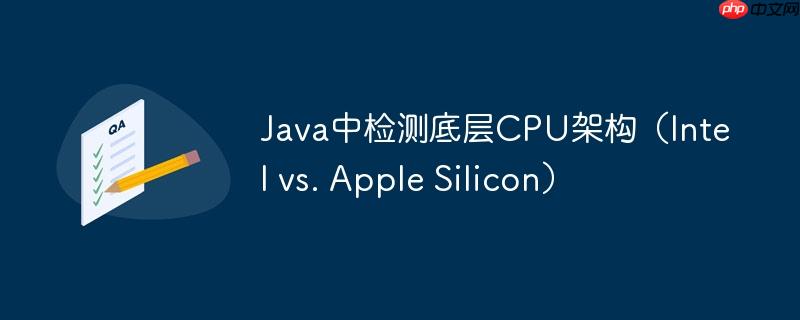
在Java应用中准确识别底层CPU架构,特别是区分Intel和Apple Silicon,不能仅依赖System.getProperty(“os.arch”),因为它反映的是JRE的架构而非宿主机的真实硬件。本教程将指导您如何通过调用操作系统特定的环境变量(如windows上的PROCESSOR_IDENTIFIER)和命令行工具(如macOS上的sysctl),来可靠地获取并解析CPU品牌字符串,从而实现跨平台但操作系统特定的CPU架构检测。
理解os.arch的局限性
在java中,system.getproperty(“os.arch”)属性通常用于获取java运行时环境(jre)的架构信息。例如,它可能会返回x86_64。然而,这个值并不总是反映底层操作系统的真实cpu架构。一个典型的例子是,在m1芯片的macos系统上运行一个intel架构的jre时,os.arch可能依然显示x86_64,这与实际的apple silicon硬件不符。因此,为了准确区分intel和apple silicon处理器,我们需要采用更深入的操作系统层面检测方法。
跨平台CPU架构检测策略
要获取底层的CPU架构信息,Java应用程序需要与操作系统进行交互。不同的操作系统提供了不同的机制来查询这些硬件细节。
windows平台检测
在Windows操作系统上,可以通过读取系统环境变量PROCESSOR_IDENTIFIER来获取CPU的详细信息。这个环境变量通常包含了处理器的品牌、型号等关键字符串,其中会明确指出“Intel”或“amd”等信息。
示例代码:
import java.io.IOException; public class CpuDetector { public static String getWindowsProcessorIdentifier() { return System.getenv("PROCESSOR_IDENTIFIER"); } public static void main(String[] args) { if (System.getProperty("os.name").startsWith("Windows")) { String identifier = getWindowsProcessorIdentifier(); System.out.println("Windows Processor Identifier: " + identifier); if (identifier != null && identifier.contains("Intel")) { System.out.println("Detected CPU: Intel (Windows)"); } else if (identifier != null && identifier.contains("AMD")) { System.out.println("Detected CPU: AMD (Windows)"); } else { System.out.println("Could not determine specific CPU type on Windows."); } } } }
示例输出:
立即学习“Java免费学习笔记(深入)”;
Windows Processor Identifier: Intel64 Family 6 Model 158 Stepping 11, GenuineIntel Detected CPU: Intel (Windows)
macOS平台检测
在macos系统上,我们可以利用sysctl命令行工具来查询CPU的品牌字符串。sysctl -n machdep.cpu.brand_string命令会返回处理器的详细名称,其中会明确包含“Intel”或“Apple M”等字样,从而区分Intel处理器和Apple Silicon处理器。
示例代码:
import java.io.BufferedReader; import java.io.IOException; import java.io.InputStreamReader; public class CpuDetector { public static String getMacCpuBrandString() throws IOException, InterruptedException { ProcessBuilder pb = new ProcessBuilder("sysctl", "-n", "machdep.cpu.brand_string"); Process p = pb.start(); try (BufferedReader br = new BufferedReader(new InputStreamReader(p.getInputStream()))) { String output = br.readLine(); int status = p.waitFor(); if (status == 0) { return output; } else { // Command failed, read error stream for details if needed try (BufferedReader errorBr = new BufferedReader(new InputStreamReader(p.getErrorStream()))) { String errorLine; StringBuilder errorOutput = new StringBuilder(); while ((errorLine = errorBr.readLine()) != null) { errorOutput.append(errorLine).append("n"); } System.err.println("Error executing sysctl: " + errorOutput.toString()); } return null; } } } public static void main(String[] args) { if (System.getProperty("os.name").equals("Mac OS X")) { try { String brandString = getMacCpuBrandString(); System.out.println("macOS CPU Brand String: " + brandString); if (brandString != null) { if (brandString.contains("Intel")) { System.out.println("Detected CPU: Intel (macOS)"); } else if (brandString.contains("Apple M")) { // e.g., "Apple M1", "Apple M2" System.out.println("Detected CPU: Apple Silicon (macOS)"); } else { System.out.println("Could not determine specific CPU type on macOS."); } } } catch (IOException | InterruptedException e) { System.err.println("Error detecting CPU on macOS: " + e.getMessage()); e.printStackTrace(); } } } }
示例输出:
立即学习“Java免费学习笔记(深入)”;
- Intel Mac: macOS CPU Brand String: Intel(R) Core(TM) i7-8700K CPU @ 3.70GHz -> Detected CPU: Intel (macOS)
- Apple Silicon Mac: macOS CPU Brand String: Apple M1 -> Detected CPU: Apple Silicon (macOS)
整合跨平台检测逻辑
为了在不同操作系统上实现统一的CPU架构检测,可以将上述逻辑整合到一个方法中:
import java.io.BufferedReader; import java.io.IOException; import java.io.InputStreamReader; public class CpuArchitectureDetector { public enum CpuType { INTEL, APPLE_SILICON, AMD, UNKNOWN } /** * 检测底层CPU架构类型。 * * @return CPU类型枚举,如果无法识别则返回UNKNOWN。 */ public static CpuType detectCpuArchitecture() { String osName = System.getProperty("os.name"); if (osName.startsWith("Windows")) { String identifier = System.getenv("PROCESSOR_IDENTIFIER"); if (identifier != null) { if (identifier.contains("Intel")) { return CpuType.INTEL; } else if (identifier.contains("AMD")) { return CpuType.AMD; } } } else if (osName.equals("Mac OS X")) { try { ProcessBuilder pb = new ProcessBuilder("sysctl", "-n", "machdep.cpu.brand_string"); Process p = pb.start(); try (BufferedReader br = new BufferedReader(new InputStreamReader(p.getInputStream()))) { String brandString = br.readLine(); int status = p.waitFor(); if (status == 0 && brandString != null) { if (brandString.contains("Intel")) { return CpuType.INTEL; } else if (brandString.contains("Apple M")) { return CpuType.APPLE_SILICON; } } } } catch (IOException | InterruptedException e) { System.err.println("Error detecting CPU on macOS: " + e.getMessage()); // Fall through to UNKNOWN } } // 可以添加其他linux等平台的检测逻辑 // else if (osName.startsWith("Linux")) { ... } return CpuType.UNKNOWN; } public static void main(String[] args) { CpuType cpu = detectCpuArchitecture(); System.out.println("Detected CPU Architecture: " + cpu); switch (cpu) { case INTEL: System.out.println("Running on an Intel processor."); // 执行Intel平台特定逻辑 break; case APPLE_SILICON: System.out.println("Running on an Apple Silicon processor."); // 执行Apple Silicon平台特定逻辑 break; case AMD: System.out.println("Running on an AMD processor."); // 执行AMD平台特定逻辑 break; case UNKNOWN: System.out.println("Unable to determine specific CPU type or running on an unsupported platform."); // 执行通用逻辑或错误处理 break; } } }
注意事项
- 错误处理: 在执行外部命令时(如ProcessBuilder),务必包含健壮的异常处理机制(IOException, InterruptedException),以应对命令执行失败、超时或权限问题。
- 性能开销: 频繁地执行外部命令可能会带来一定的性能开销。如果CPU架构信息在应用程序生命周期内是固定的,建议在启动时检测一次并缓存结果。
- 输出解析: 操作系统命令的输出格式可能会因版本或语言设置而略有不同。在解析字符串时,应采用灵活的contains()方法而非严格的equals(),以提高兼容性。
- 权限问题: 执行某些系统命令可能需要特定的用户权限。确保您的应用程序拥有执行所需命令的权限。
- 其他操作系统: 对于Linux等其他操作系统,也可以通过读取/proc/cpuinfo文件或使用lscpu等命令来获取CPU信息。本教程主要关注Windows和macOS。
总结
通过利用操作系统特定的环境变量和命令行工具,Java应用程序可以可靠地检测底层CPU架构,从而区分Intel、Apple Silicon或其他类型的处理器。这种方法克服了System.getProperty(“os.arch”)的局限性,使得开发者能够根据不同的硬件平台执行特定的业务逻辑或优化。在实现时,务必注意错误处理、性能和输出解析的健壮性。


评论(已关闭)
评论已关闭